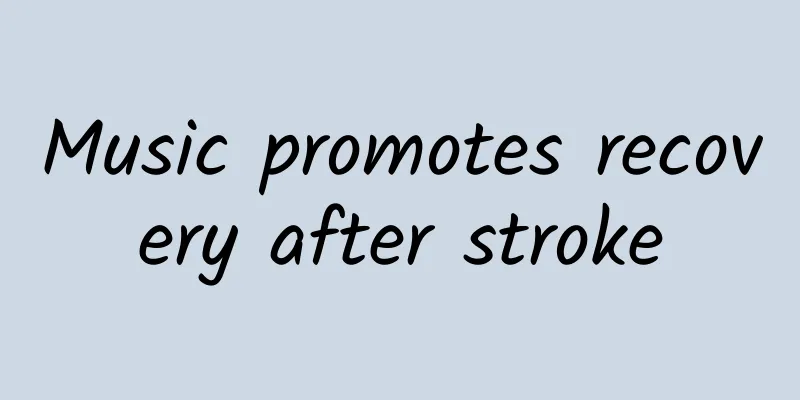Music promotes recovery after stroke

|
Thousands of years ago, the ancients proposed that "Gong, Shang, Jiao, Wei, and Yu" corresponded to the five internal organs "spleen, lung, liver, heart, and kidney" respectively. Ancient doctors used the five tones to regulate the five internal organs, adjust the body and mind, and promote physical and mental recovery, thereby achieving the purpose of preventing and curing diseases. Although music therapy has a long history, it is an emerging rehabilitation method in modern medicine. It exerts a therapeutic effect by stimulating brain functions involving movement, cognition, speech, emotion, and senses. In recent years, more and more studies have found that music has a good effect in improving cognitive disorders, language disorders, and emotional disorders such as depression or anxiety. Therefore, music therapy, as a rehabilitation method after stroke, is very worthy of promotion and popularization. How to implement music therapy Music therapy comes in many forms and can be divided into active participation (playing an instrument/singing) or passive participation (listening). These treatments can be carried out at home or in a rehabilitation facility; they can be one-on-one or in a group. Considering the different ways each patient grasps music and the severity of the disease, music therapists divide music therapy into three categories to help patients better integrate music. 1. Receptive Music Therapy Receptive music therapy is generally described as listening to music. Patients are asked to listen to specific music, such as the "Falling Wild Goose on the Plain Sand" with a vast and tranquil artistic conception and full of life, and the "Guangling San" with a generous and passionate melody. The melody and rhythm of the music can affect the patient's nervous system, thereby achieving the purpose of treatment. Therapists can choose different music according to different patients. By listening to music suitable for the patients, the central nervous system can be relaxed, the subconsciousness of the patients can be mobilized, and under the guidance of the therapist, the patients can re-understand themselves through association or imagination. 2. Re-creative music therapy Re-creative music therapy means that patients should not only listen, but also participate in various music activities. There is no requirement for the patient's musical foundation, and the main emphasis is on the patient's participation. Patients can use musical instruments/any objects to play music, and can choose to sing solo or with others. In the process of playing music with others, it can increase the patient's communication, cultivate a sense of belonging and collective consciousness, and thus alleviate the occurrence of psychological diseases such as depression. 3. Improvisational Music Therapy Improvisational music therapy refers to the creation of music on the spot, and the form of the music is not fixed (such as singing, instrumental music, or even the sound of small objects in life being hit, etc.). We can create lyrics, melodies, song accompaniments in an instant, or use objects around us to create rhythms, syllables, tones, etc. The simplest form is to use percussion, pick up a pen or a cup, and hit the object with your hand to generate rhythm. A relatively more advanced method is that patients can compose their own music under the guidance of a music therapist. Improvisational music therapy has higher requirements on the music therapist's musical skills and professional level, but this method can quickly establish a therapeutic relationship with the patient and obtain the patient's cooperation. In addition, music therapy can be flexible and varied according to the type of music, the patient's cultural background, and treatment needs. It is not limited to one type of music therapy and can be combined with multiple forms of music. In addition to single music intervention for patients, music can also be combined with other intervention therapies, such as music therapy combined with exercise therapy, transcranial magnetic therapy, acupuncture therapy, etc., to develop individualized treatment plans for patients. As a non-drug auxiliary rehabilitation treatment method, music therapy is time-saving, labor-saving, non-invasive and has no adverse reactions, and is easily accepted by patients. With the continuous in-depth research of scholars from various countries, music therapy will surely become more and more standardized and bring more benefits to patients. |
<<: Can acupuncture be used to fight acne?
Recommend
Is eating bananas good for the fetus during pregnancy?
The diet of pregnant women directly affects the g...
How to check if there is any problem with the cervix
In fact, all women are afraid that their cervix w...
How does general anesthesia affect children?
General anesthesia is a medical procedure that us...
How can women enlarge their breasts the fastest and most effectively
Key reminder: There are many foods in daily life ...
After eating poisonous mushrooms, I saw a snake with a diameter of one meter
As the saying goes, "Man is iron and rice is...
Leucorrhea after abortion is more like water
Secretion is a normal physiological need of women...
Is it normal to have gas during pregnancy?
During pregnancy, a woman's body will undergo...
Fragment warning! Orthokeratology contact lenses are also afraid of "cold"
Winter is here, the temperature drops sharply Eve...
What is the reason for seeing blood after sex?
In fact, many female friends care about their bod...
Does eating pomegranates make you fat? What to do if pomegranate juice turns blue after washing
Pomegranates are rich in vitamins, dietary fiber ...
Is it necessary to have a uterine curettage if I have a spontaneous abortion one month into my pregnancy?
Many people cannot tell the difference between sp...
What are the crab offal that cannot be eaten? How to deal with crab offal
September and October are good times to eat crabs...
Is it good to eat durian during menstruation?
Dysmenorrhea troubles many female friends, so onc...
Female bad breath Huoxiang Qingwei capsule
Everyone may have heard of Niuhuang Qingwei Pills...
Use condoms during medical abortion
Even though medical abortion does not cause as mu...









